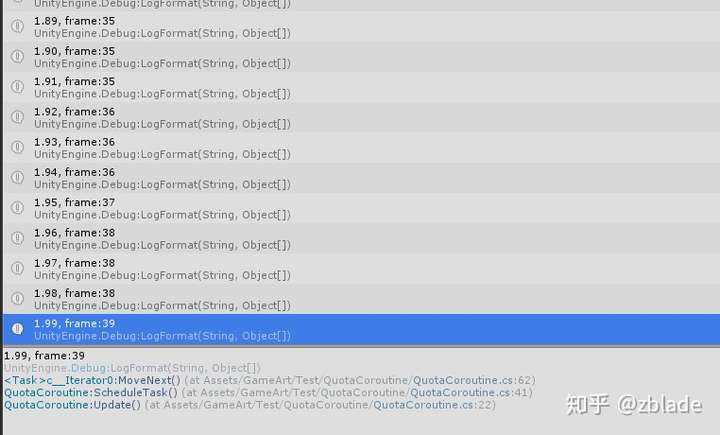unity协程coroutine浅析
转载请标明出处:http://www.cnblogs.com/zblade/
一、序言
在unity的游戏开发中,对于异步操作,有一个避免不了的操作: 协程,以前一直理解的懵懵懂懂,最近认真充电了一下,通过前辈的文章大体理解了一下,在这儿抛砖引玉写一些个人理解。当然首先给出几篇写的非常精彩优秀的文章,最好认真拜读一下:
Unity3d中协程的原理,你要的yield return new xxx的真正理解之道
好了,接下来就从一个小白的视角开始理解协程。
二、常见使用协程的示例
经常,我们会利用monobehaviour的startcoroutine来开启一个协程,这是我们在使用unity中最常见的直观理解。在这个协程中执行一些异步操作,比如下载文件,加载文件等,在完成这些操作后,执行我们的回调。 举例说明:
1 2 3 4 5 6 7 8 9 10 11 12 13 14 15 16 17 18 19 20 21 22 23 24 25 26 | public static void Download(System.Action finishCB){ string url = "https: xxxx"; StartCoroutine(DownloadFile(url));}private static IEnumerator DownloadFile(string url){ UnityWebRequest request = UnityWebRequest.Get(url); request.timeout = 10; yield return request.SendWebRequest(); if(request.error != null) { Debug.LogErrorFormat("加载出错: {0}, url is: {1}", request.error, url); request.Dispose(); yield break; } if(request.isDone) { string path = "xxxxx"; File.WriteAllBytes(path, request.downloadHandler.data); request.Dispose(); yiled break; }} |
这个例子中,用到了几个关键词: IEnumerator/yield return xxx/ yield break/StartCoroutine, 那么我们从这几个关键词入手,去理解这样的一个下载操作具体实现。
1、关键词 IEnumerator
这个关键词不是在Unity中特有,unity也是来自c#,所以找一个c#的例子来理解比较合适。首先看看IEnumerator的定义:
1 2 3 4 5 6 | public interface IEnumerator{ bool MoveNext(); void Reset(); Object Current{get;}} |
从定义可以理解,一个迭代器,三个基本的操作:Current/MoveNext/Reset, 这儿简单说一下其操作的过程。在常见的集合中,我们使用foreach这样的枚举操作的时候,最开始,枚举数被定为在集合的第一个元素前面,Reset操作就是将枚举数返回到此位置。
迭代器在执行迭代的时候,首先会执行一个 MoveNext, 如果返回true,说明下一个位置有对象,然后此时将Current设置为下一个对象,这时候的Current就指向了下一个对象。当然c#是如何将这个IEnumrator编译成一个对象示例来执行,下面会讲解到。
2、关键词 Yield
c#中的yield关键词,后面有两种基本的表达式:
yield return <expresion>
yiled break
yield break就是跳出协程的操作,一般用在报错或者需要退出协程的地方。
yield return是用的比较多的表达式,具体的expresion可以以下几个常见的示例:
WWW : 常见的web操作,在每帧末调用,会检查isDone/isError,如果true,则 call MoveNext
WaitForSeconds: 检测间隔时间是否到了,返回true, 则call MoveNext
null: 直接 call MoveNext
WaitForEndOfFrame: 在渲染之后调用, call MoveNext
好了,有了对几个关键词的理解,接下来我们看看c#编译器是如何把我们写的协程调用编译生成的。
三、c#对协程调用的编译结果
这儿没有把上面的例子编译生成,就借用一下前面文章中的例子 :b
1 2 3 4 5 6 7 8 9 10 | class Test{ static IEnumerator GetCounter() { for(int count = 0; count < 10; count++) { yiled return count; } }} |
其编译器生成的c++结果:
1 2 3 4 5 6 7 8 9 10 11 12 13 14 15 16 17 18 19 20 21 22 23 24 25 26 27 28 29 30 31 32 33 34 35 36 37 38 39 40 41 42 43 44 45 46 47 48 49 50 51 52 53 54 55 56 57 58 59 60 61 62 63 64 65 66 67 68 69 70 71 72 73 74 75 76 77 78 79 80 | internal class Test { // GetCounter获得结果就是返回一个实例对象 private static IEnumerator GetCounter() { return new <GetCounter>d__0(0); } // Nested type automatically created by the compiler to implement the iterator [CompilerGenerated] private sealed class <GetCounter>d__0 : IEnumerator<object>, IEnumerator, IDisposable { // Fields: there'll always be a "state" and "current", but the "count" // comes from the local variable in our iterator block. private int <>1__state; private object <>2__current; public int <count>5__1; [DebuggerHidden] public <GetCounter>d__0(int <>1__state) { //初始状态设置 this.<>1__state = <>1__state; } // Almost all of the real work happens here //类似于一个状态机,通过这个状态的切换,可以将整个迭代器执行过程中的堆栈等环境信息共享和保存 private bool MoveNext() { switch (this.<>1__state) { case 0: this.<>1__state = -1; this.<count>5__1 = 0; while (this.<count>5__1 < 10) //这里针对循环处理 { this.<>2__current = this.<count>5__1; this.<>1__state = 1; return true; Label_004B: this.<>1__state = -1; this.<count>5__1++; } break; case 1: goto Label_004B; } return false; } [DebuggerHidden] void IEnumerator.Reset() { throw new NotSupportedException(); } void IDisposable.Dispose() { } object IEnumerator<object>.Current { [DebuggerHidden] get { return this.<>2__current; } } object IEnumerator.Current { [DebuggerHidden] get { return this.<>2__current; } } } } |
代码比较直观,相关的注释也写了一点,所以我们在执行开启一个协程的时候,其本质就是返回一个迭代器的实例,然后在主线程中,每次update的时候,都会更新这个实例,判断其是否执行MoveNext的操作,如果可以执行(比如文件下载完成),则执行一次MoveNext,将下一个对象赋值给Current(MoveNext需要返回为true, 如果为false表明迭代执行完成了)。
通过这儿,可以得到一个结论,协程并不是异步的,其本质还是在Unity的主线程中执行,每次update的时候都会触发是否执行MoveNext。
四、协程的衍生使用
既然IEnumerator可以这样用,那我们其实可以只使用MoveNext和Current,就可以写一个简易的测试协程的例子,Ok,来写一个简易的例子,来自leader的代码,偷懒就复用了 :D
1 2 3 4 5 6 7 8 9 10 11 12 13 14 15 16 17 18 19 20 21 22 23 24 25 26 27 28 29 30 31 32 33 34 35 36 37 38 39 40 41 42 43 44 45 46 47 48 49 50 51 52 53 54 55 56 57 58 59 60 61 62 63 64 65 66 67 | using System.Collections;using System.Collections.Generic;using UnityEngine;using UnityEngine.Profiling;public class QuotaCoroutine : MonoBehaviour{ // 每帧的额度时间,全局共享 static float frameQuotaSec = 0.001f; static LinkedList<IEnumerator> s_tasks = new LinkedList<IEnumerator>(); // Use this for initialization void Start() { StartQuotaCoroutine(Task(1, 100)); } // Update is called once per frame void Update() { ScheduleTask(); } void StartQuotaCoroutine(IEnumerator task) { s_tasks.AddLast(task); } static void ScheduleTask() { float timeStart = Time.realtimeSinceStartup; while (s_tasks.Count > 0) { var t = s_tasks.First.Value; bool taskFinish = false; while (Time.realtimeSinceStartup - timeStart < frameQuotaSec) { // 执行任务的一步, 后续没步骤就是任务完成 Profiler.BeginSample(string.Format("QuotaTaskStep, f:{0}", Time.frameCount)); taskFinish = !t.MoveNext(); Profiler.EndSample(); if (taskFinish) { s_tasks.RemoveFirst(); break; } } // 任务没结束执行到这里就是没时间额度了 if (!taskFinish) return; } } IEnumerator Task(int taskId, int stepCount) { int i = 0; while (i < stepCount) { Debug.LogFormat("{0}.{1}, frame:{2}", taskId, i, Time.frameCount); i++; yield return null; } }} |
说一下思路: 在开始的时候,构建一个IEnuerator实例塞入链表中,然后再后续的每帧update的时候,取出这个实例,执行一次MoveNext,一直到都执行完后,移除这个实例,这样就不用显示的调用StartCoroutine,也可以类似的触发执行MoveNext :D
看运行结果:

可行。OK,关于unity的协程就写到这儿了,接下来将一下xlua中对于协程的实现。
五、Lua中的协程
Lua中的协程和unity协程的区别,最大的就是其不是抢占式的执行,也就是说不会被主动执行类似MoveNext这样的操作,而是需要我们去主动激发执行,就像上一个例子一样,自己去tick这样的操作。
Lua中协程关键的三个API:
coroutine.create()/wrap: 构建一个协程, wrap构建结果为函数,create为thread类型对象
coroutine.resume(): 执行一次类似MoveNext的操作
coroutine.yield(): 将协程挂起
比较简易,可以写也给例子测试一下:
1 2 3 4 5 6 7 8 9 10 11 12 13 14 15 16 17 18 19 20 21 22 23 | local func = function(a, b) for i= 1, 5 do print(i, a, b) endendlocal func1 = function(a, b) for i = 1, 5 do print(i, a, b) coroutine.yield() endendco = coroutine.create(func)coroutine.resume(co, 1, 2)--此时会输出 1 ,1, 2/ 2,1,2/ 3, 1,2/4,1,2/5,1,2co1 = coroutine.create(func1)coroutine.resume(co1, 1, 2)--此时会输出 1, 1,2 然后挂起coroutine.resume(co1, 3, 4)--此时将上次挂起的协程恢复执行一次,输出: 2, 1, 2 所以新传入的参数3,4是无效的 |
我们来看看xlua开源出来的util中对协程的使用示例又是怎么结合lua的协程,在lua端构建也给协程,让c#端也可以获取这个实例,从而添加到unity端的主线程中去触发update。
看一下调用的API:
local util = require 'xlua.util'
local gameobject = CS.UnityEngine.GameObject('Coroutine_Runner')
CS.UnityEngine.Object.DontDestroyOnLoad(gameobject)
local cs_coroutine_runner = gameobject:AddComponent(typeof(CS.Coroutine_Runner))
return {
start = function(...)
return cs_coroutine_runner:StartCoroutine(util.cs_generator(...))
end;
stop = function(coroutine)
cs_coroutine_runner:StopCoroutine(coroutine)
end
}
start操作,本质就是将function包一层,调用util.csgenerator,进一步看看util中对cs_generator的实现:
local move_end = {}
local generator_mt = {
__index = {
MoveNext = function(self)
self.Current = self.co()
if self.Current == move_end then
self.Current = nil
return false
else
return true
end
end;
Reset = function(self)
self.co = coroutine.wrap(self.w_func)
end
}
}
local function cs_generator(func, ...)
local params = {...}
local generator = setmetatable({
w_func = function()
func(unpack(params))
return move_end
end
}, generator_mt)
generator:Reset()
return generator
end
代码很短,不过思路很清晰,首先构建一个table, 其中的key对应一个function,然后修改去元表的_index方法,其中包含了MoveNext函数的实现,也包含了Reset函数的实现,不过这儿的Reset和IEnumerator的不一样,这儿是调用coroutine.wrap来生成一个协程。这样c#端获取到这个generator的handleID后,后面每帧update回来都会执行一次MoveNext,如果都执行完了,这时候会return move_end,表明协程都执行完了,返回false给c#端清空该协程的handleID.






【推荐】国内首个AI IDE,深度理解中文开发场景,立即下载体验Trae
【推荐】编程新体验,更懂你的AI,立即体验豆包MarsCode编程助手
【推荐】抖音旗下AI助手豆包,你的智能百科全书,全免费不限次数
【推荐】轻量又高性能的 SSH 工具 IShell:AI 加持,快人一步
· AI与.NET技术实操系列(二):开始使用ML.NET
· 记一次.NET内存居高不下排查解决与启示
· 探究高空视频全景AR技术的实现原理
· 理解Rust引用及其生命周期标识(上)
· 浏览器原生「磁吸」效果!Anchor Positioning 锚点定位神器解析
· 全程不用写代码,我用AI程序员写了一个飞机大战
· DeepSeek 开源周回顾「GitHub 热点速览」
· 记一次.NET内存居高不下排查解决与启示
· MongoDB 8.0这个新功能碉堡了,比商业数据库还牛
· .NET10 - 预览版1新功能体验(一)